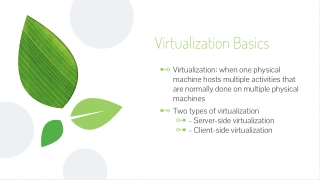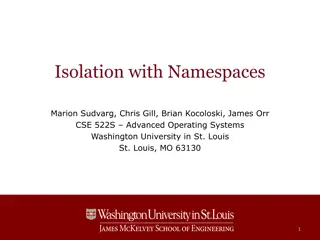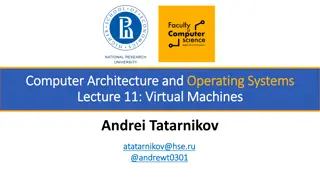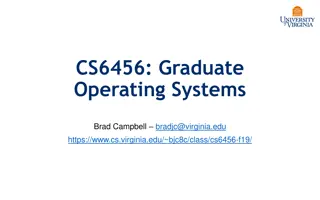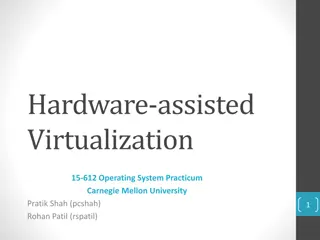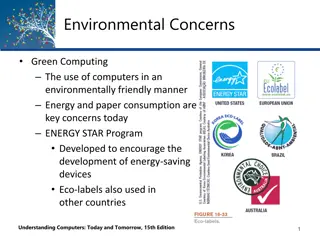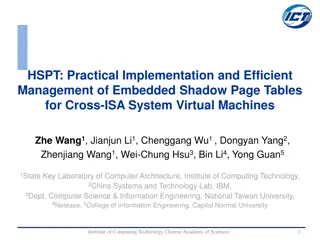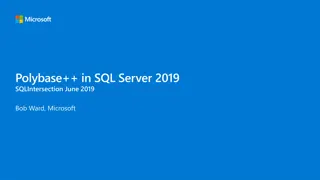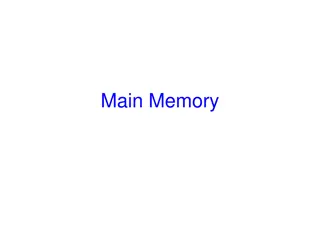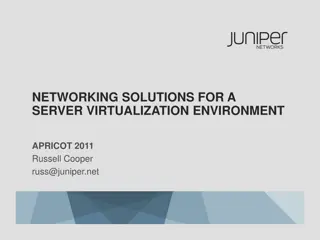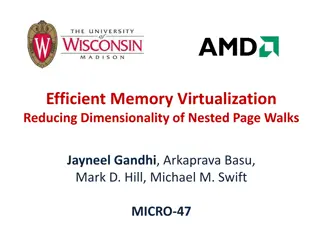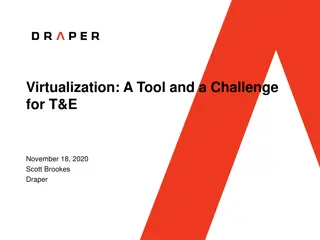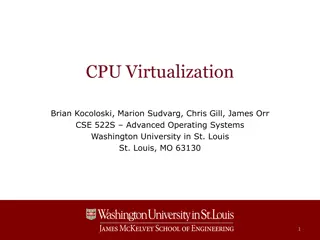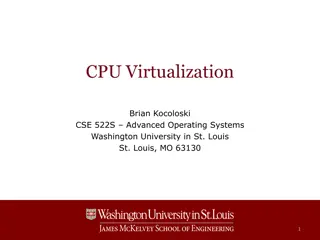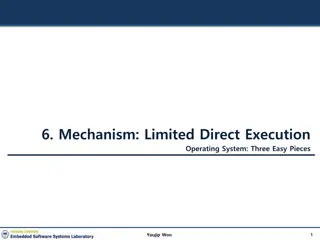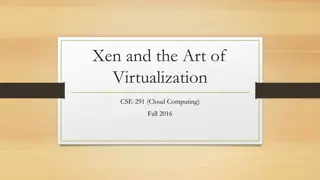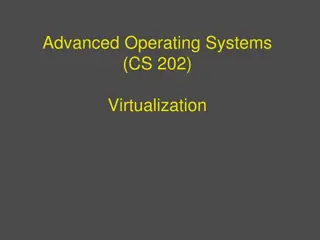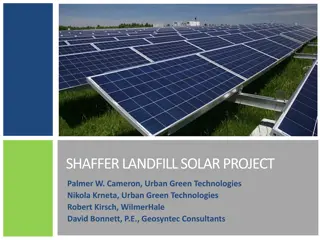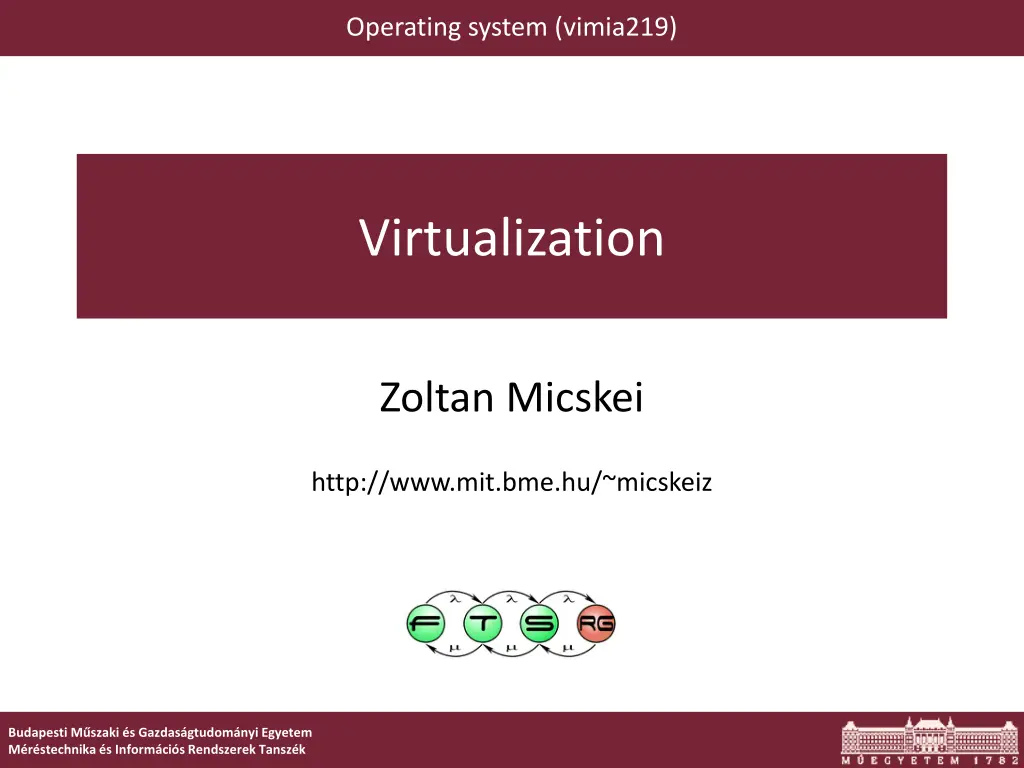
Understanding Platform Virtualization in Computers
Explore the concept of platform virtualization, where a full computer can run multiple operating systems on a single hardware. Learn about its history, benefits, and the taxonomy of virtual machines. Discover the buzzwords and misconceptions surrounding virtualization in the realm of computer systems.
Download Presentation

Please find below an Image/Link to download the presentation.
The content on the website is provided AS IS for your information and personal use only. It may not be sold, licensed, or shared on other websites without obtaining consent from the author. If you encounter any issues during the download, it is possible that the publisher has removed the file from their server.
You are allowed to download the files provided on this website for personal or commercial use, subject to the condition that they are used lawfully. All files are the property of their respective owners.
The content on the website is provided AS IS for your information and personal use only. It may not be sold, licensed, or shared on other websites without obtaining consent from the author.
E N D
Presentation Transcript
Operating system (vimia219) Virtualization Zoltan Micskei http://www.mit.bme.hu/~micskeiz Budapesti M szaki s Gazdas gtudom nyi Egyetem M r stechnika s Inform ci s Rendszerek Tansz k
Virtualization Central concept in computers Virtualization: hiding the actual parameters of a resource from its users, e.g. o presenting a resource as separate logical ones, o presenting separate resources as one logical Virtual memory, virtual filesystem 2
The virtualization buzzword Packaged applications Computer virtualization Misused termonology Dymamic management, lifecycle, templates Thin clients Hiding the storage structure + OS level virtualization: separate OS containers Desktop products 3
Virtual machine taxonomy* VM sees an ABI VM sees a hardware Java, .NET Multiprog- rammed OS Source: J. Smith and Ravi Nair, The architecture of virtual machines, IEEEComputer, vol. 38, 2005, pp. 32-38. * taxonomy ~ structure for presenting relationships between concepts 4
Platform virtualization Platform virtualization: virtualizing a full computer, running multiple OS on one hardware o Also known as: server, computer, hardware virtualization.. Concepts: o Host machine = physical computer o Guest machine = virtual computer o Virtual Machine Monitor (VMM): program managing the virtual machines 6
History of platform virtualization ~1960 - IBM CP-40 system o in the mainframe products x86 virtualization o Seemed impossible o 1997: Stanford, Disco projects o 1998: VMware solution o 2000- Other solutions Now: o has its own business o becomes commodity 7
Why is platform virtualization good? Building test systems HW consolidation Legacy systems On-demand architectures High availability, disaster recovery Portable applications 8
Platform virtualization Two approaches: GUEST Management App. App. App. App. App. Management OS App. OS OS OS OS Virt. SW OS Virt. SW Hardware Hardware Neve: Main component: VMM Virtual Machine Monitor VMM Virtual Machine Monitor HOST Hypervisor Hosted Bare-metal Mainly desktop productsL: VMware Workstation, Server, Player, Oracle VirtualBox, MS VirtualPC, KVM, UML Mainly server products: VMware ESX Server, Xen Enterprise, MS Hyper-V 9
Requirements Requirements for a virtualization solution: Equivalence: programs in a VM should perform indistinguishable from running on the hardware Resource control: the VMM should handle all the physical resources Efficiency: most of the VM s instructions should run directly on the hardware Gerald J. Popek, Robert P. Goldberg: Formal Requirements for Virtualizable Third Generation Architectures. Commun. ACM 17(7): 412-421 (1974) 12
Main problem The system must be protected from the guests E.g.: HLT (Halt) instruction o Desirable: only the VM should stop o But all VMs would stop if executed Solution: VMM monitors the guest instructions o Privileged instructions should be handled 13
Theoretical background CPU virtualization Memory virtualization I/O virtualization
Basic methods Full emulation Full state of the virtual hardware is stored in the emulator (registers, flags) Virtual machine Application Virtual HW Every instruction is inspected by the VMM Emulator State of virtual HW Instruction is applied in the emulator, transforms the instruction, executes Pro: Different CPU can be emulated Con: Slow HW 15
Basic methods Trap and emulate Trap: hardware exception handling, which resumes execution after the handler Virtual machine Application Non-privileged instructions are directly executed on the hardware Virtual HW Emulator State of virtual HW Privileged or sensitive instructions cause a trap, VMM handles it HW support is required: protection modes (e.g. x86 ring) VM runs in a lower mode Privileged instructions should case a trap when called from a non-privileged mode HW 16
Issues with x86 virtualization Some architectures can be easily virtualized o x86 cannot From ~250 instructions 17 violate the classical requirements, e.g. POPF instruction: modifies EFLAGS register o But if not executed in ring 0, doesn t throw an exception Privileged state can be detected o OS can detected whether it s running in a VM Conclusion: the trap & emulate method cannot be used on the original x86 17
Solutions for virtualizing x86 Binary translation (software) Paravirtualization Hardware-assisted virtualization 18
Binary translation most of the instructions run directly privileged instructions translated runtime doesn t need source caches translated code guest OS not aware of virtualization 19
Binary translation example Guest Code Translation Cache mov ebx, eax mov ebx, eax vEPC start cli mov [VIF], 0 and ebx, ~0xfff and ebx, ~0xfff mov ebx, cr3 mov [CO_ARG], ebx sti call HANDLE_CR3 ret mov [VIF], 1 test [INT_PEND], 1 jne call HANDLE_INTS jmp HANDLE_RET Source: Carl Waldspurger, Introduction to Virtual Machines 20
Paravirtualization Modifying the source of the guest OS Replacing problematic instructions Hypercall: calling the VMM directly 21
Hardware-assisted virtualization ~2005: Intel Virtualization Technology (VT-x) and AMD AMD-V HW support: root mode, VMCS o Instructions: VMCALL, VMLAUNCH trap & emulate now works 22
What is the best? Answer changes constantly o Depends on the environment, workload o BT used to be more matures, but.. Most products mix several techniques 2006. VMware: BT is better than HW assisted virtualization 2008. VMware: Paravirtalization + BT is better than pure BT 2009. Comparing Hardware Virtualization Performance Utilizing VMmark v1.1 23
Theoretical background CPU virtualization Memory virtualization I/O virtualization
Memory virtualization (software) Guest page tables VM1 VM2 Guest: virtual memory Guest: physical memory Machine: physical memory VM allocation page tables Instead of double translation: shadow page tables ISSUE: synchronization 25
Memory virtualization (paravirtualization) Also uses shadow page tables Modifying the guest OS source code When the OS modifies it s page tables, it should notify the VMM also 26
Memory virtualization (hardware) HW support in the recent CPUs o AMD Rapid Virtualization Indexing , Intel Extended Page Tables Nested page table o Storing guest physical -> machines physical translation o Traversed by HW address translation Tagging TLB entries Great performance increase: o 2008. 04., KVM: MMU paravirtualization is dead o 2009., VMware: Performance Evaluation of AMD RVI Hardware Assist, 42% improvement in some cases 27
Theoretical background CPU virtualization Memory virtualization I/O virtualization
Handling I/O devices (software) Virtual machine Emulating the whole real communication Guest OS Unmodified driver VMM Emulated virtual HW HW manager I/O device 29
Handling I/O devices (paravirtualization) Virtual machine Virtual machine Guest OS Guest OS Unmodified driver Paravirt. driver Simplified calls, communication through shared memory VMM VMM Emulated virtual HW HW manager HW manager I/O device I/O device Special package installed in the VM: o VMware Tools, Virtual PC Additions o Always install these! 30
Handling I/O devices (hardware) Hardware support o Intel VT-d, AMD IOMMU o PCI standard extensions: I/O Virtualization (IOV) I/O devices o can be shared between VMs o can be directly assigned to one VM 31
Players http://www.virtualization.info/radar/ 33
Players ESXi, vSphere open source hypervisor XenServer, XenApp Virtual PC, Hyper-V, System Center Solaris Containers, Oracle VM, VirtualBox Xen Kernel based Virtual Machine (KVM) mainframe, powerVM 34
Centralized management DEMO Resource pools VM maps Performance graphs Live Migration moving VMs between hosts on the fly 35
Cloud computing ??? 36
Cloud computing Cloud 37
Types of cloud computing IaaS Getting a VM Amazon EC2, RackSpace Getting a runtime environment Java container, .NET, database MS Azure, Google AppEngine PaaS SaaS Getting a service Google Docs, SalesForce CRM 38
More information Ole Agesen et al.: The evolution of an x86 virtual machine monitor, SIGOPS Oper. Syst. Rev. 44, 4 (December 2010) P. Barham et al.: Xen and the Art of Virtualization, SIGOPS Oper. Syst. Rev. 37, 5 (October 2003) 40
Summary Virtualization: became commodity Conflicting terminology Many competing vendors Operating systems o Core functions implemented in the hypervisor o Purpose of general OS? 41

